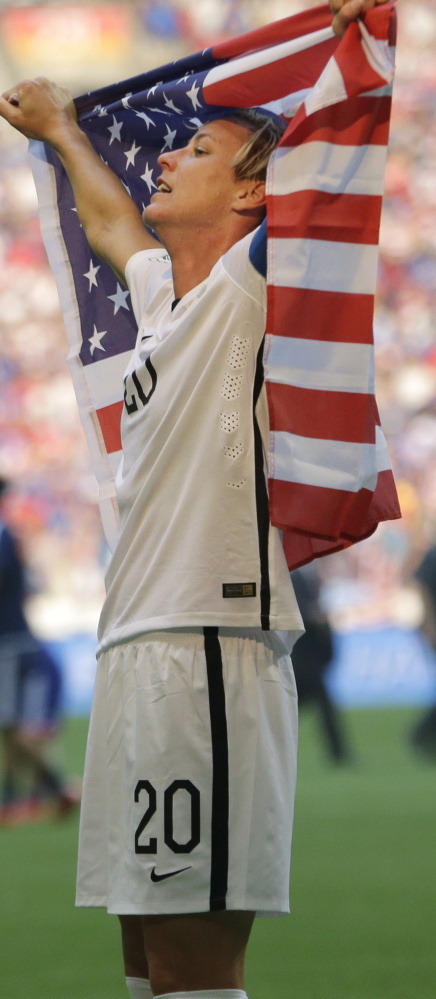VANCOUVER, British Columbia — Atop BC Place’s championship stage Sunday night, 21 U.S. women’s national team players formed a semi-circle around Abby Wambach and Christie Rampone. The squad’s longest-serving members accepted the gold-plated World Cup trophy and, on the count of three, hoisted it to the heavens.
It was a moment 16 years in the making and one that symbolized triumph and transition.
The Americans won a record third world title and, coupled with their collection of Olympic gold medals, raised their count of major championships to seven.
But with the Olympics just a year away, the roster is sure to undergo change.
The 5-2 victory over Japan probably marked the end of major international competition for Wambach, a 35-year-old forward with four World Cups behind her, and Rampone, a 40-year-old defender with five. Wambach started three of the first four games before accepting a substitute role. Rampone made two appearances.
Both were on the field at the end of Sunday’s match, a touching salute to longtime contributors.
Other players will move on as well. This was, after all, a veteran group: 10 players are age 30 or older. Carli Lloyd, the three-goal scorer in the final and Golden Ball recipient as the tournament’s most outstanding player, will turn 33 this month. Lloyd and several others will remain in the mix for the Olympics and then perhaps consider stepping aside ahead of the next World Cup.
Wambach, Rampone and Lloyd are sure-bet U.S. Hall of Famers.
The next generation is headed by defender Julie Johnston, 23, and midfielder Morgan Brian, 22, who played pivotal roles this summer. Johnston logged every minute of the tournament, and Brian made six appearances and helped stabilize central midfield in the last three games.
With a new World Cup cycle starting, Ellis will aim to integrate other young players, such as Crystal Dunn, 23, the last World Cup cut. Dunn is a versatile and athletic prospect who tops the National Women’s Soccer League in scoring but plays outside back and wing for the U.S.
“They have shown very clearly they belong,” Ellis said of Johnston and Brian. “There have been big moments in big games for them. In terms of the future, it’s very bright. There will be transition after this World Cup.”
There is no major transition with the coaching staff. Early in the tournament, when the Americans were sputtering along and a berth in the final appeared unlikely, Ellis’ decisions were subjected to increasing scrutiny. If the United States failed to reach the final, would she retain her job? But her adjustments in the knockout stage, providing more support for Lloyd in midfield, and settling on the lineup and formation in the final matches, brought accolades from players and observers alike.
“I just want to thank Jill,” Lloyd said. “I know lots of people were worried about us but we all held together, we all stayed the course, we all executed the game plan. What Jill did and the coaching staff did from start to finish earned us this World Cup.”
Ellis, in turn, credited players.
“As the teams get harder and the pressure gets bigger,” she said, “this team gets better because that is how they are engineered. …
“These players were born for big moments. This is what they relish.”
Ellis’ contract runs through next year’s Olympics.
While the defense was the team’s strength through the month-long event, the offense was at its best at the beginning and end. The Americans scored three goals in the opener against Australia and five in the final; in between they managed just six in five games.
Lloyd recorded all six of her goals in the last four matches to join Celia Sasic of Germany atop the tournament scoring chart. Eleven of the team’s 14 goals were scored by midfielders.
Ellis, a longtime U.S. youth national team coach, had been on a tight timetable since accepting the job in spring 2014. She had one year to prepare the team for the World Cup – two years is optimal – and now has 12 months to get ready for the Olympics in Brazil, assuming the Americans qualify. Only 20 players are permitted on the Olympic roster, three fewer than the World Cup, which creates increased competition for a roster spot.
Send questions/comments to the editors.



Success. Please wait for the page to reload. If the page does not reload within 5 seconds, please refresh the page.
Enter your email and password to access comments.
Hi, to comment on stories you must . This profile is in addition to your subscription and website login.
Already have a commenting profile? .
Invalid username/password.
Please check your email to confirm and complete your registration.
Only subscribers are eligible to post comments. Please subscribe or login first for digital access. Here’s why.
Use the form below to reset your password. When you've submitted your account email, we will send an email with a reset code.